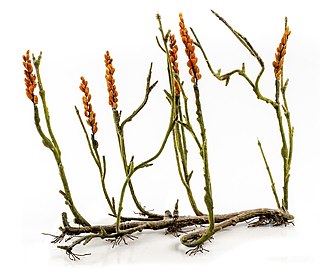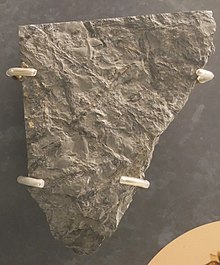
The zosterophylls are a group of extinct land plants that first appeared in the Silurian period. The taxon was first established by Banks in 1968 as the subdivision Zosterophyllophytina; they have since also been treated as the division Zosterophyllophyta or Zosterophyta and the class or plesion Zosterophyllopsida or Zosteropsida. They were among the first vascular plants in the fossil record, and had a world-wide distribution. They were probably stem-group lycophytes, forming a sister group to the ancestors of the living lycophytes. By the late Silurian a diverse assemblage of species existed, examples of which have been found fossilised in what is now Bathurst Island in Arctic Canada.

Psilophyton is a genus of extinct vascular plants. Described in 1859, it was one of the first fossil plants to be found which was of Devonian age. Specimens have been found in northern Maine, USA; Gaspé Bay, Quebec and New Brunswick, Canada; the Czech Republic; and Yunnan, China. Plants lacked leaves or true roots; spore-forming organs or sporangia were borne on the ends of branched clusters. It is significantly more complex than some other plants of comparable age and is thought to be part of the group from within which the modern ferns and seed plants evolved.

Zosterophyllum was a genus of Silurian-Devonian vascular land plants with naked branching axes on which usually kidney-shaped sporangia were arranged in lateral positions. It is the type genus for the group known as zosterophylls, thought to be part of the lineage from which modern lycophytes evolved. More than 20 species have been described.

Pertica is a genus of extinct vascular plants of the Early to Middle Devonian. It has been placed in the "trimerophytes", a strongly paraphyletic group of early members of the lineage leading to modern ferns and seed plants.

Adoketophyton is a genus of extinct vascular plants of the Early Devonian. The plant was first described in 1977 based on fossil specimens from the Posongchong Formation, Wenshan district, Yunnan, China. These were originally named Zosterophyllum subverticillatum; later the species was transferred to a new genus as Adoketophyton subverticillatum. One cladistic analysis suggested that it is a lycophyte, related to the zosterophylls. Other researchers regard its placement within the vascular plants as uncertain.
Danziella is a genus of extinct vascular plants of the Early Devonian. Fossils found in the Artois region of northern France were first described as Zosterophyllum artesianum, but a later review by Edwards showed that they did not fit the circumscription of that genus.
Jugumella is a genus of extinct plants of the Late Silurian. Fossils were found in Kazakhstan. Jugumella was considered a possible zosterophyll in a 2006 study. It was listed as a zosterophyll by Hao and Xue in 2013.
Lycopodolica is a genus of extinct plants of the Late Silurian. Fossils were found in the Rashkov Beds in Podolia in modern Ukraine. Plants there are preserved as compressions without internal detail. Lycopodolica had stems (axes) which appear to have branched and which are covered with lax, hair- or thread-like outgrowths. Considered to be a lycophyte, Lycopodolica differs from Baragwanathia in the nature of its outgrowths or enations. It was listed as a lycopsid by Hao and Xue in 2013.
Yarravia is a genus of extinct vascular plants mainly known from fossils found in Victoria, Australia. Originally the rocks in which they were found were considered to be late Silurian in age; more recently they have been found to be Early Devonian. Specimens consist only of incomplete leafless stems, some of which bore groups of spore-forming organs or sporangia which were fused, at least at the base.

The Battery Point Formation is a geologic formation in Quebec. It preserves fossils dating back to the early Emsian to early Eifelian the lower Devonian period.
This article records new taxa of fossil plants that are scheduled to be described during the year 2015, as well as other significant discoveries and events related to paleobotany that are scheduled to occur in the year 2015.
This article contains papers in paleobotany that were published in 2016.
This article records new taxa of plants that are scheduled to be described during the year 2017, as well as other significant discoveries and events related to paleobotany that are scheduled to occur in the year 2017.
This article records new taxa of plants that are scheduled to be described during the year 2018, as well as other significant discoveries and events related to paleobotany that occurred in the year 2018.
This article records new taxa of fossil plants that are scheduled to be described during the year 2019, as well as other significant discoveries and events related to paleobotany that are scheduled to occur in the year 2019.
This article records new taxa of plants that were described during the year 2014, as well as other significant discoveries and events related to paleobotany that occurred in the year 2014.
This article records new taxa of fossil plants that are scheduled to be described during the year 2021, as well as other significant discoveries and events related to paleobotany that are scheduled to occur in the year 2021.
This paleobotany list records new fossil plant taxa that were to be described during the year 2022, as well as notes other significant paleobotany discoveries and events which occurred during 2022.
This paleobotany list records new fossil plant taxa that were to be described during the year 2012, as well as notes other significant paleobotany discoveries and events which occurred during 2012.
This paleobotany list records new fossil plant taxa that were to be described during the year 2023, as well as notes other significant paleobotany discoveries and events which occurred during 2023.





